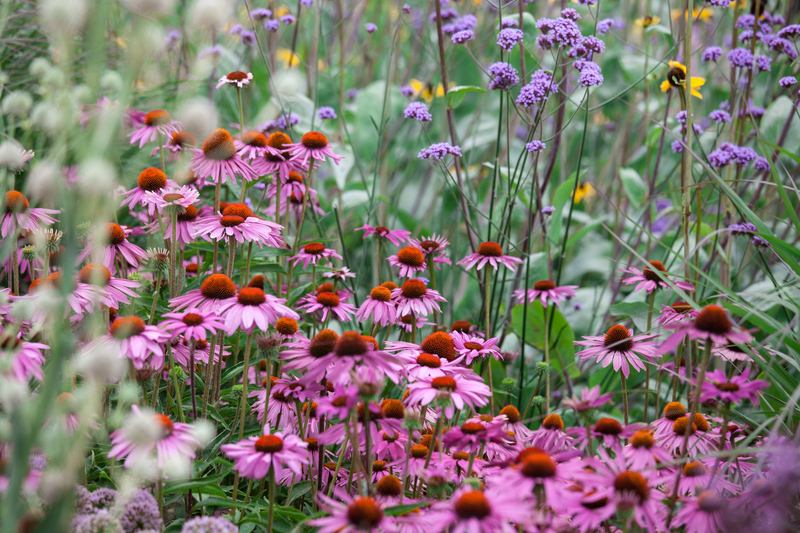How container gardening is transforming urban spaces
Posted on 30/05/2025
How Container Gardening is Transforming Urban Spaces
Urban environments are often associated with concrete, glass, and steel rather than vibrant greenery. Yet, with the rise of container gardening, this image is rapidly changing. From busy city balconies to community rooftops, container-based gardening is converting dull landscapes into thriving pockets of nature. This article explores how container gardening is reshaping urban living, enhancing city aesthetics, and providing countless environmental and social benefits.
What is Container Gardening?
Container gardening refers to growing plants--flowers, herbs, vegetables, and even trees--in pots or other containers rather than directly in the ground. Containers can range from traditional terra cotta pots and recycled buckets to vertical wall planters and self-watering boxes.
- Accessible for all skill levels and budgets
- Adaptable to any urban setting, from windowsills to rooftops
- Ideal for rented homes or small spaces
As city dwellers seek ways to integrate greenery into their daily lives, the versatility of container gardening makes it the go-to solution.

Why is Urban Container Gardening Gaining Popularity?
Urbanization has led to less green space and more environmental challenges. However container-based gardens offer practical and creative ways for city residents to reconnect with nature. Here are the key drivers behind the trend:
- Space efficiency: Containers fit into tight spots where traditional gardens cannot.
- Mobility and flexibility: Plants can be rearranged or moved to optimize sunlight and adapt to weather changes.
- Personalization: From edible herbs to vibrant annuals, individuals tailor their gardens to their tastes and needs.
- Community building: Shared rooftop and courtyard gardens foster social connection.
- Improved air quality and urban aesthetics
The Environmental Benefits of Container Gardening in Cities
One of the most compelling aspects of container gardening in urban areas is its positive environmental impact. Urban green spaces, even on a small scale, contribute to healthier cities.
Improved Air Quality
Plants are natural air purifiers, absorbing pollutants and producing oxygen. Even a modest container garden can reduce airborne toxins and improve overall air quality in dense neighborhoods.
Temperature Regulation
Urban heat islands--areas where heat is trapped by concrete and asphalt--can cause cities to become uncomfortably hot. Container plants provide shade and help cool surfaces, reducing local temperatures and saving energy on cooling.
Biodiversity Enhancement
Urban container gardens attract beneficial insects, pollinators like bees and butterflies, and even birds. This surge in biodiversity supports local ecosystems, making city environments more resilient and vibrant.
Stormwater Management
Containers filled with soil and plants absorb rainfall, helping to prevent water runoff and urban flooding--an increasingly important benefit given the erratic weather fuelled by climate change.
Social and Health Advantages of Container Gardening in Urban Settings
Beyond environmental perks, container gardening in cities nurtures individual well-being and community spirit.
Stress Reduction and Mental Health
Connecting with plants is a proven antidote to stress. Whether tending a potted tomato or nurturing a window box of flowers, the act of gardening offers therapeutic benefits, including reduced anxiety and improved focus.
Food Security and Nutrition
Many urban residents use container gardens to grow fresh herbs and vegetables, improving access to nutritious, affordable food. This homegrown produce can supplement family diets while reducing grocery bills.
Empowerment and Education
Community container gardens serve as living classrooms, teaching sustainable practices and fostering environmental stewardship. Children and adults alike benefit from hands-on gardening opportunities, developing skills and confidence.
Creating Social Bonds
Shared gardening spaces offer a platform for neighbors to connect, share harvests, and exchange knowledge. These interactions build stronger, more cohesive communities within the typically isolating urban landscape.
Innovative Container Gardening Techniques for Urban Spaces
The creativity of urban gardeners knows no bounds. Here are some inventive approaches that are revolutionizing container gardening in cities:
Vertical Gardens
By stacking containers or using wall-mounted planters, gardeners maximize limited space to create stunning living walls. These vertical container gardens not only save space but also transform blank walls into lush, green backdrops.
Self-Watering Containers
Urban life is fast-paced, and many residents worry about maintaining plant health. Self-watering pots and irrigation systems help ensure consistent moisture, making urban gardening more accessible and less time-consuming.
Upcycled and Recycled Containers
Sustainability and creativity go hand in hand. From old boots to drawers and shipping pallets, city dwellers repurpose everyday items as planters, embodying the spirit of eco-conscious urban gardening.
Mobile Gardens
For renters or those on the move, portable containers like rolling carts or pallet boxes allow gardens to move with their owners. This flexibility ensures no green investment is wasted.
Transforming Urban Real Estate
As the urban container gardening trend grows, property developers and city planners are taking notice. Container gardens are now integral to:
- Apartment rooftops and shared terraces
- Balcony gardening in crowded city centers
- Green courtyards in residential complexes
- Community gardens in public spaces
These initiatives boost property value, enhance livability, and help cities meet sustainability targets. For many real estate projects, integrating container gardens is now essential both for aesthetics and functionality.
Common Plants for Urban Container Gardens
Not all plants thrive in containers, especially in the variable microclimates found in cities. However, a wide range of plants for container gardening have proven both hardy and productive:
- Herbs: Basil, mint, thyme, rosemary, and chives flourish in pots and require little maintenance.
- Leafy Greens: Lettuce, spinach, kale, and arugula offer quick harvests and high nutrition value.
- Fruit-Bearing Plants: Compact tomato varieties, peppers, strawberries, and dwarf citrus trees.
- Edible Flowers: Nasturtiums, pansies, and violets add beauty and zest to dishes.
- Succulents and Cacti: Ideal for hot, sunny balconies with minimal watering needs.
Tip: Always match plant selection with sunlight, wind exposure, and container size to ensure healthy growth.
Challenges and Solutions in Urban Container Gardening
While the advantages are clear, container gardening in cities does present some challenges. Here are the most common obstacles and expert fixes:
Limited Sunlight
Tall buildings often cast long shadows, making sunlight a rare commodity. Gardeners can overcome this by:
- Choosing shade-tolerant plants
- Using reflective surfaces to direct light
- Rotating containers regularly
Poor Air Quality and Pollution
Airborne pollutants can stress plants, but dusting and rinsing leaves regularly helps. Selecting hardy, resilient plants ensures urban gardens continue to thrive even in busy city centers.
Wind and Weather Extremes
Rooftop and balcony gardens may face intense wind and sun. Solutions include:
- Windbreaks like lattice screens or denser planting
- Heavy, stable containers to prevent tipping
- Mulching to maintain soil moisture
Resource Constraints
City dwellers may have limited access to quality soil or water. Many urban gardeners rely on pre-mixed potting soils and compact, efficient irrigation systems to conserve water and simplify care.
Container Gardening: A Sustainable Urban Solution
In the larger context of urban sustainability, container gardening offers massive potential.
- Reduces food miles, since herbs and veggies are grown where they're needed
- Cuts down on urban waste through composting and recycling containers
- Supports urban wildlife and pollinators
- Contributes to climate resilience through cooling and flood mitigation
Integrating Technology with Urban Container Gardening
Modern smart gardening devices, such as sensor-driven watering systems, automated grow lights, and app-based reminders, are making container gardening foolproof for even the busiest city dwellers.
How to Start Your Urban Container Garden
Are you ready to join the container gardening revolution? Here is a step-by-step guide:
- Assess Space and Light: Choose locations with enough natural light; balconies, windowsills, and rooftops are prime spots.
- Select the Right Containers: Ensure good drainage, the appropriate size for your chosen plants, and materials that suit your climate.
- Pick Suitable Plants: Focus on hardy species adapted to your available sun, wind, and weather conditions.
- Use High-Quality Soil: Opt for soilless potting mixes that facilitate root health and drainage.
- Set Up Efficient Watering: Invest in self-watering systems, drip lines, or watering schedules that suit your lifestyle.
- Stay Consistent: Regularly check for pests, prune plants, and adjust arrangements seasonally to maximize yields and aesthetics.

The Future of Container Gardening in Urban Environments
As cities continue to densify, container gardening is poised to play an ever-greater role in urban planning. More municipalities are supporting green roofs, community gardening, and horticultural outreach programs. Innovative designs, such as hydroponic towers and modular garden pods, promise to make urban gardening even more accessible.
With container gardening transforming urban spaces, the vision of greener, healthier, and more livable cities is within reach. Every balcony tomato plant, rooftop herb box, or community flower tub contributes to a more sustainable, engaging, and resilient urban future.
Conclusion: Greening Our Cities One Container at a Time
Container gardening has evolved from a simple hobby into a powerful movement reshaping the look, feel, and health of cities worldwide. By providing accessible, adaptable, and sustainable green spaces, it offers everyone--from apartment dwellers to city planners--a stake in nurturing urban nature.
Whether you have a single pot on a windowsill or an array of planters on a rooftop, your efforts matter. As more people discover the joys and benefits of urban container gardening, we're seeing not just a trend, but a genuine transformation of urban spaces--producing environments that are not only livable, but truly thrive.
Start your own container garden today, and become part of the green revolution changing cities for the better!

